What's New
Displaying results 2281 - 2290 of 4052
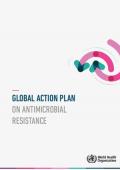
Resource | Publications,
Antimicrobial resistance threatens the very core of modern medicine and the sustainability of an effective, global public health response to the enduring threat from infectious diseases. Systematic misuse and overuse of these drugs in human medicine and food production have put every nation at risk. Few replacement products are in the pipeline. Without harmonized and immediate action on a global scale, the world is heading towards a post-antibiotic era in which common infections could once again kill.
This action plan underscores the need for an effective “one health” approach involving coordination among numerous international sectors and actors, including human and veterinary medicine, agriculture, finance, environment, and wellinformed consumers.
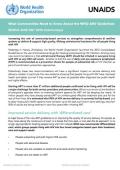
Resource | Guidelines,
Developed by Southern African AIDS Trust, with the support of WHO and UNAIDS, the summary of the the WHO’s New Consolidated guidelines on the use of antiretroviral drugs for treating and preventing HIV infection is now available.
Among many new recommendations is that antiretroviral therapy (ART) should be initiated in everyone living with HIV at any CD4 cell count. Another is that the use of daily oral pre-exposure prophylaxis (PrEP) is recommended as a prevention choice for people at substantial risk of HIV infection as part of combination prevention approaches.
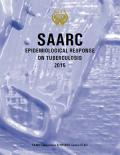
Resource | Publications,
The SAARC Region continues to bear a significant burden of tuberculosis despite making significant progress in the global efforts to eliminate TB. Although notified TB cases have been steadily increasing, a decline in the prevalence is seen in all Member States, some reporting more than 50% decline since 1990. With good implementation of DOTS by Member States, the level of "multi-drug resistant" (MDR) TB among newly-detected cases is low. The year 2015 marks the deadline for global TB targets set in the context of the Millennium Development Goals (MDGs), and is a year of transitions: from the MDGs to a new era of Sustainable Development Goals (SDGs), and from the Stop TB Strategy to the End TB Strategy.
This report is an excellent review of the current status and future plans for the control of TB in the SAARC Region. It includes information on burden of tuberculosis in the SAARC region, including incidence, prevalence, mortality along with the MDR-TB, TB/HIV confection etc. It also covers the information of the year 2014 and has been prepared on the basis of information collected from member countries during the year 2015 and by reviewing other related documents.
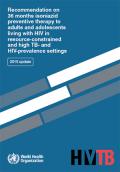
Resource | Publications,
In 2011, the World Health Organization (WHO) issued "Guidelines for intensified tuberculosis case-finding and isoniazid preventive therapy for people living with HIV in resource constrained settings" and conditionally recommended the use of at least 36 months of isoniazid preventive therapy or IPT (as a proxy for lifelong or continuous treatment) for people living with HIV in high TB-prevalence and transmission settings, based on the results of unpublished studies. It was decided to update the evidence as the studies are now published, and explore whether the findings might require any change in the recommendation of lifelong IPT for people living with HIV.
The main objective of this update is to reassess the recommendation to provide IPT for 36 months to children and adults living with HIV, including pregnant women, those receiving antiretroviral therapy (ART), and those who have successfully completed TB treatment and are living in settings with high TB and HIV prevalence and transmission, based on the requirements of the WHO Guidelines Review Committee.
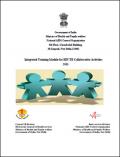
Resource | Tools,
Tuberculosis continues to be a public health challenge in India and it is commonest opportunistic infection in persons living with HIV (PLHIV), TB is the foremost cause of dath among people living with HIV. To mitigate the effect of dual burden of HIV and TB co-infection the ministry of Health and Family Welfare, Government of India through its National AIDS Control Organisation (NACO) and Central TB Division has been undertaking joint collaborative efforts as per the National Framework for HIV TB collaborative activities in India.
Training of staff under NACP and RNTCP is very crucial for strengthening of TB/HIV activities and imparting updated knowledge regarding HIV/TB to program staff. To streamline the training, both the programmes envisage, that uniform, standardized modular training be imparted to all the programme and general health staff throughout the country.
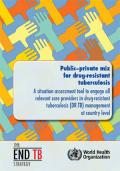
Resource | Tools,
As described in the Framework for engagement of all health-care providers in the management of drug-resistant tuberculosis, a careful country-based analysis about the current status of the management of drug-resistant tuberculosis (DR-TB) patients, with a focus on all the various health-care providers, will show the way forward towards achieving the goal of universal access to quality diagnosis and treatment for all cases of TB, including DR-TB.
This situation assessment tool, as an annex of the above-mentioned framework, enables a country or other users to gather the needed data that will serve as a basis for designing a sound plan of expanding DR-TB management, by engaging all relevant care providers.
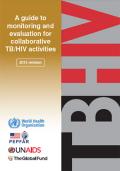
Resource | Tools,
The 2015 revision of a guide to monitoring and evaluation for collaborative TB/HIV activities is developed through close collaboration between the World Health Organization, the United States President’s Emergency Plan for AIDS Relief, the Joint United Nations Programme on HIV and AIDS and the Global Fund to Fight AIDS, Tuberculosis and Malaria and extensive consultations with partners and national programmes. It renews focus on quality of data and its utility for programmatic response.
The monitoring indicators are broadly categorized into core indicators for global and national level use and optional indicators. While the core indicators enable monitoring of key TB/HIV interventions as in the past, some are modified to enhance accuracy of data and others to broaden scope.
This guide is developed to assist TB and HIV programme managers and other stakeholders in monitoring and
evaluation for collaborative TB/HIV activities. It is intended to facilitate collection of standardized data and to help in interpretation and dissemination of these data for programme improvement at national and subnational level.
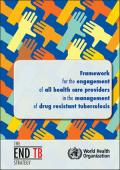
Resource | Publications,
The Framework for engagement of all health-care providers in the management of drug-resistant tuberculosis has been developed to support countries in the implementation of public–private mix (PPM) for drug-resistant tuberculosis (DR-TB). This document complements other guidance and practical tools on PPM for TB control and prevention. It serves as a guidance document for countries in engaging providers and partners from outside the national TB programmes (NTPs) to address the complexity of the programmatic management of DR-TB.
The framework describes approaches for engaging different health-care providers and partners in diverse aspects of DR-TB care and management, including clinical care, public health tasks, patient-centred care, advocacy, funding mobilization, regulation and social protection. It describes the engagement of non-NTP providers and partners, which is not limited to diagnosis and treatment, but also includes other important aspects of DR-TB care, depending on the capacity and preference of the non-NTP providers and partners.
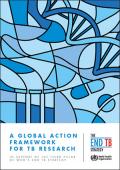
Resource | Publications,
The World Health Organization (WHO), with contributions from many stakeholders, has developed a Global Action Framework for TB Research to foster high-quality national and global TB research over the next 10 years to 2025.
The first part of the framework describes how to strengthen TB research in low- and middle-income countries most affected by TB by developing a national TB research plan.
The second part of the framework describes how to enhance TB research globally by applying efforts to building strong research partnerships and networks and securing robust funding for research.
The third part of the framework describes WHO’s activities in support of the framework.
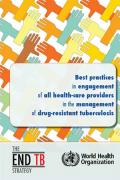
Resource | Publications,
This publication documents best practices in engagement of health-care providers in the management of drug-resistant tuberculosis (DR-TB). The aim is to share experiences and approaches that are being implemented in countries and by various health-care providers and partners. Some of the case studies in this document are also presented in the WHO’s Framework for engagement of all health-care providers in the management of drug-resistant tuberculosis. In the current document, case studies are presented by approach, for easier reference by readers who are interested in examples and experiences around the globe in implementation of public–private mix for DR-TB (PPM DR-TB).
The WHO/Global TB Programme (GTB) team continues to document best practices for sharing in the public domain via the WHO/GTB website. National TB programmes and partners are encouraged to share their case studies with others via the website.





